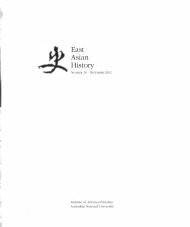Mujaku Dochu (1653-1744) and 17th-Century ... - East Asian History
Mujaku Dochu (1653-1744) and 17th-Century ... - East Asian History
Mujaku Dochu (1653-1744) and 17th-Century ... - East Asian History
Create successful ePaper yourself
Turn your PDF publications into a flip-book with our unique Google optimized e-Paper software.
MUJAKU DOCHO<br />
29<br />
Thus <strong>Mujaku</strong> was an elite monk; a scholar <strong>and</strong> administrator, <strong>and</strong> a<br />
good poet. A considerable poet-monk of Edo, Ban'an Genshi rE)]{<br />
(d. 1739), thought <strong>Mujaku</strong> such a great poet that he proposed his works<br />
should be published.23 <strong>Mujaku</strong> then was not part of the movement to<br />
popularise of Zen by the adoption of popular beliefs, prayers <strong>and</strong> funerary<br />
Buddhism, or the mechanical use of koan <strong>and</strong> prepared, set answers<br />
to them, that entered Myashinji in the sixteenth century or the popular<br />
Buddhism of the Sata sect.2 4 Rather, <strong>Mujaku</strong> opposed such practices as a<br />
dilution of "pure Zen" (junsui Zen Mi). <strong>Mujaku</strong> moved in the circles<br />
of other elite monks, <strong>and</strong> met with the emperor when made abbot of<br />
Myashinji, <strong>and</strong> he often had to go to Edo rIP or Hagi f;i( to attend his<br />
sub-temple's patron, the daimya of Chashu.25<br />
Japan <strong>and</strong> the <strong>East</strong> <strong>Asian</strong> Buddhist World<br />
<strong>Mujaku</strong> is often seen by scholars as part of a general dismissal of the<br />
Ming-dynasty I!I'I Ch'an brought by the Obaku monks from China. Whereas<br />
once Tokugawa Japan was thought to have been totally isolated from<br />
external influences <strong>and</strong> its Buddhism considered stagnant <strong>and</strong> degenerate,<br />
this view has now been much modified, if not rejected.2 6 However,<br />
accounts of such external influence on Tokugawa Buddhism are almost<br />
entirely confined to the introduction of the Lin-chi Ch'an of Mount Huangpo<br />
Jilt LlJ, the so-called Obaku. Occasional mention is sometimes made<br />
of the TS'ao-tung Ch'an \!JilPJ monk Hsin-ylieh Hsing-ch'ou !L,{I<br />
(1642-96), who came to Nagasaki in 1677. His teachings were blocked<br />
by the Obaku monks, but he was then invited by the daimya of Mito 71<<br />
P in 1683, in whose domain he taught until his death.27 Tsuji Zennosuke<br />
i±zWJ, whose history of Japanese Buddhism was authoritative until<br />
recently, even stated that Obaku was supported by the shogunate only<br />
in "the context of the revival of the Rinzai school", which suggests an<br />
exclusive focus on the Lin-chi Ch'an of Mount Huang-po.28 More recent<br />
scholars have not only stressed the broader influence of Obaku, even on<br />
Myashinji, as a form of stimulus, but also the Japanese Zen rejection of<br />
some of the Obaku practices <strong>and</strong> regulations.2 9 Indeed, <strong>Mujaku</strong> was one<br />
23 SbOhyilkinenroku[Chronological Record of<br />
the Life of Shining Ice] MSS, age 69 sai. (Note<br />
all works marked as MSS, unless otherwise<br />
indicated, are from the reproductions of Mu jaku's<br />
manuscripts, or those copied by his pupils,<br />
held in the Zenbunka kenkyusho library,<br />
Iwhich is located in the grounds of Hanazono<br />
University, Kyoto. Currently a project team<br />
headed by Professor Yoshizawa Katsuhiro,<br />
centred in the International Research Institute<br />
for Zen Buddhism, Hanazono University, is in<br />
the process of placing all the available texts<br />
Ion the internet in full colour, which will<br />
make them easier to read than photocopied<br />
texts, or those on microfilm. The microfilm<br />
has deteriorated, <strong>and</strong> so they are generally<br />
not accessible. The original manuscripts<br />
are scattered in a number of holdings in<br />
monasteries, sub-temples <strong>and</strong> libraries. The<br />
pagination is my own.) This manuscript is<br />
a chronicle of <strong>Mujaku</strong>'s life. See also Iida,<br />
CakushO<strong>Mujaku</strong>Dachu, p.193. Genshi wrote<br />
a preface for <strong>Mujaku</strong>'s collection of poetry,<br />
the Hougaishu [The Non-Buddhist Collection<br />
of Writings by Beneficial Rain], see Houda<br />
kogyoshU [Collection of Crystallisations in<br />
Space from the Hall of Beneficial Rain] MSS,<br />
(VoI.7l), 1.4b-l la.<br />
24 For Myoshinji, see Martin Collcutt, Five<br />
Mountains: The Rinzai Zen Monastic Institution<br />
in Medieval Japan (Cambridge:<br />
Harvard University Press, 1981), p.129. For<br />
Soto popular religion, see Duncan Ryuken<br />
Williams, The Other Side of Zen: A Social<br />
<strong>History</strong> of Soto Zen Buddhism in Tokugawa<br />
Japan (Princeton: Princeton University Press,<br />
200S), passim. For the prepared answers, see<br />
Victori Sogen Hori, Zen S<strong>and</strong>: The Book of<br />
Capping Phrases for Kaan Practice (Honolulu:<br />
University of Hawai'i Press, 2003), pp.<br />
ix, 63 passim, <strong>and</strong> Ibuki Atsushi, Zen no<br />
rekishi (Kyoto: Hozokan, 2001), p.244 on<br />
missan or monsan.<br />
25 !ida, CakushO <strong>Mujaku</strong> Dachu, passim.<br />
26 See Francis H. Cook, "Heiao, Kamakura,<br />
<strong>and</strong> Tokugawa Periods inJapan," in Charles S.<br />
Prebish, ed., Buddhism: A Modern Perspective<br />
(Pennsylvania: Pennsylvania State University<br />
Press, 1975)' p.227; cf. Heinrich Dumoulin<br />
(trans James W. Heisig <strong>and</strong> Paul Knitter),<br />
Zen Buddhism: A <strong>History</strong>: Japan (New York:<br />
Macmillan, 1990), p.305, for examples of this<br />
view.<br />
27 Imaeda Aishin, Zenshu no rekishi [A <strong>History</strong><br />
of the Zen Sect], Nihon rekishi shinsho<br />
(Tokyo: Shibuodo, 1966), reprint, 214ff, 234.<br />
Note Dumoulin, Zen Buddhism, pp.303-S,<br />
who does not even mention Hsing-ch'ou.<br />
28 Cited in Dumoulin, Zen Buddhism,<br />
p.303.<br />
29 T. Griffith Foulk, "'Rules of Purity' in<br />
Japanese Zen," in Heine <strong>and</strong> Wright, Zen<br />
ClasSiCS, pp.lSO-S6.

















